Canadore College Nursing Assignment: Dementia Wellness Program Report
VerifiedAdded on 2023/04/12
|6
|919
|184
Report
AI Summary
This nursing assignment outlines a wellness program designed to improve the challenging symptoms experienced by dementia patients in a care facility. The program targets senior adults aged 65 and above, focusing on interventions such as cognitive behavioral therapy, making lists for memory support, and establishing routines for daily activities. The assignment incorporates elements of the ICF and PEO models to ensure a safe and supportive environment. The program aims to address symptoms like poor memory, cognition, and depression, aligning with rehabilitation principles to enhance patient function and promote holistic recovery. The rationale includes fostering wellness, reducing hospitalization rates, and improving the quality of life for dementia patients. Evidence-based strategies are proposed, and a timeline for implementation is provided. The assignment concludes with the expectation of improved patient outcomes after six months.
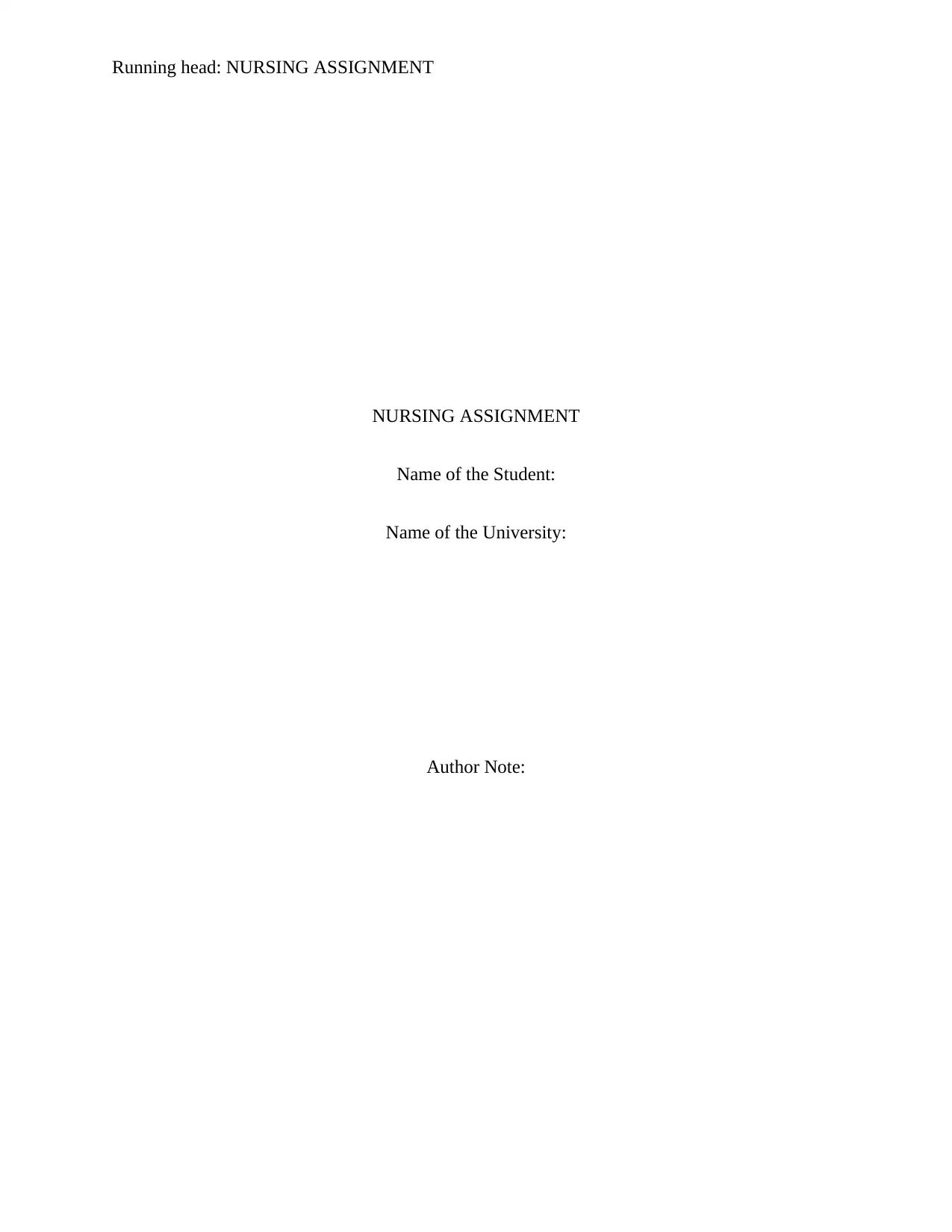
Running head: NURSING ASSIGNMENT
NURSING ASSIGNMENT
Name of the Student:
Name of the University:
Author Note:
NURSING ASSIGNMENT
Name of the Student:
Name of the University:
Author Note:
Paraphrase This Document
Need a fresh take? Get an instant paraphrase of this document with our AI Paraphraser
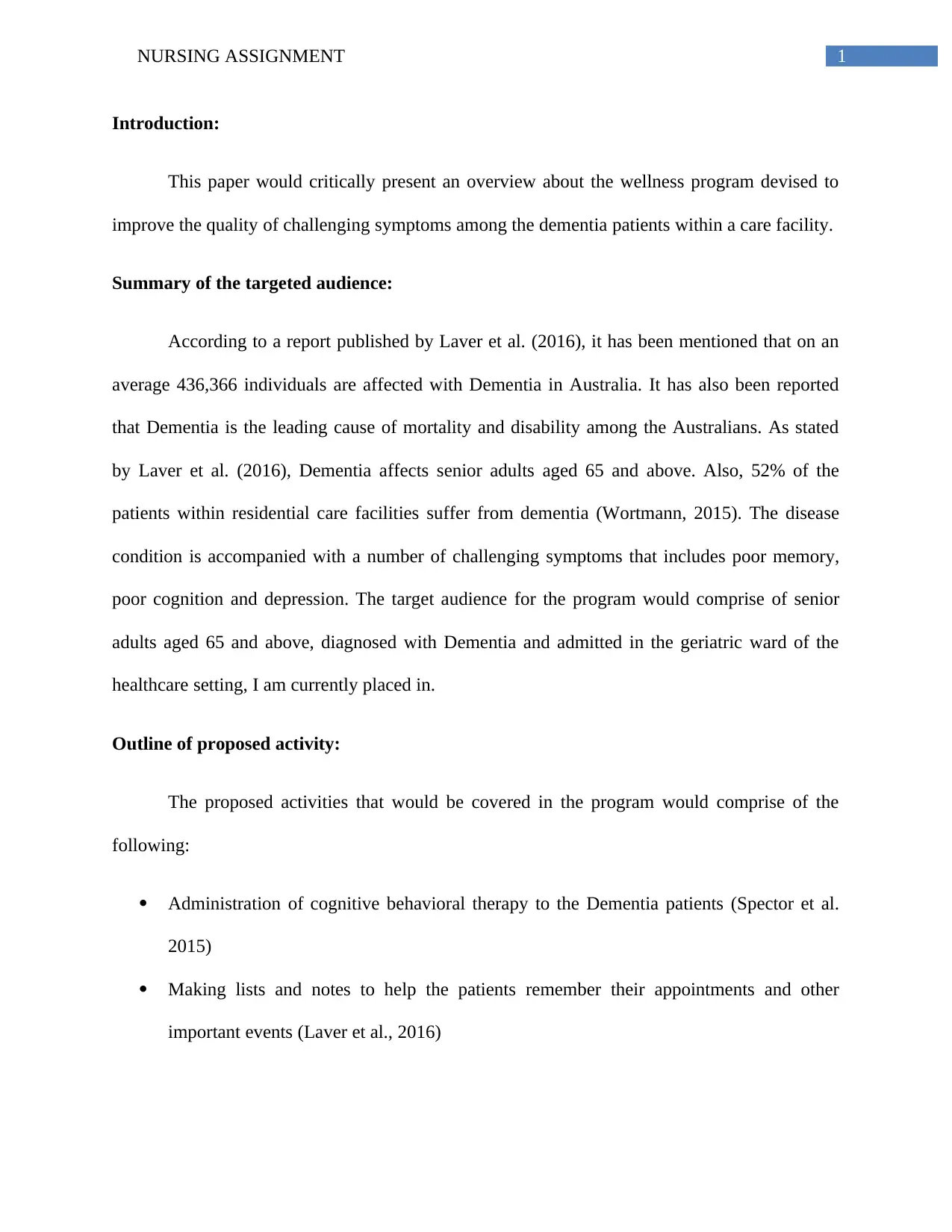
1NURSING ASSIGNMENT
Introduction:
This paper would critically present an overview about the wellness program devised to
improve the quality of challenging symptoms among the dementia patients within a care facility.
Summary of the targeted audience:
According to a report published by Laver et al. (2016), it has been mentioned that on an
average 436,366 individuals are affected with Dementia in Australia. It has also been reported
that Dementia is the leading cause of mortality and disability among the Australians. As stated
by Laver et al. (2016), Dementia affects senior adults aged 65 and above. Also, 52% of the
patients within residential care facilities suffer from dementia (Wortmann, 2015). The disease
condition is accompanied with a number of challenging symptoms that includes poor memory,
poor cognition and depression. The target audience for the program would comprise of senior
adults aged 65 and above, diagnosed with Dementia and admitted in the geriatric ward of the
healthcare setting, I am currently placed in.
Outline of proposed activity:
The proposed activities that would be covered in the program would comprise of the
following:
Administration of cognitive behavioral therapy to the Dementia patients (Spector et al.
2015)
Making lists and notes to help the patients remember their appointments and other
important events (Laver et al., 2016)
Introduction:
This paper would critically present an overview about the wellness program devised to
improve the quality of challenging symptoms among the dementia patients within a care facility.
Summary of the targeted audience:
According to a report published by Laver et al. (2016), it has been mentioned that on an
average 436,366 individuals are affected with Dementia in Australia. It has also been reported
that Dementia is the leading cause of mortality and disability among the Australians. As stated
by Laver et al. (2016), Dementia affects senior adults aged 65 and above. Also, 52% of the
patients within residential care facilities suffer from dementia (Wortmann, 2015). The disease
condition is accompanied with a number of challenging symptoms that includes poor memory,
poor cognition and depression. The target audience for the program would comprise of senior
adults aged 65 and above, diagnosed with Dementia and admitted in the geriatric ward of the
healthcare setting, I am currently placed in.
Outline of proposed activity:
The proposed activities that would be covered in the program would comprise of the
following:
Administration of cognitive behavioral therapy to the Dementia patients (Spector et al.
2015)
Making lists and notes to help the patients remember their appointments and other
important events (Laver et al., 2016)
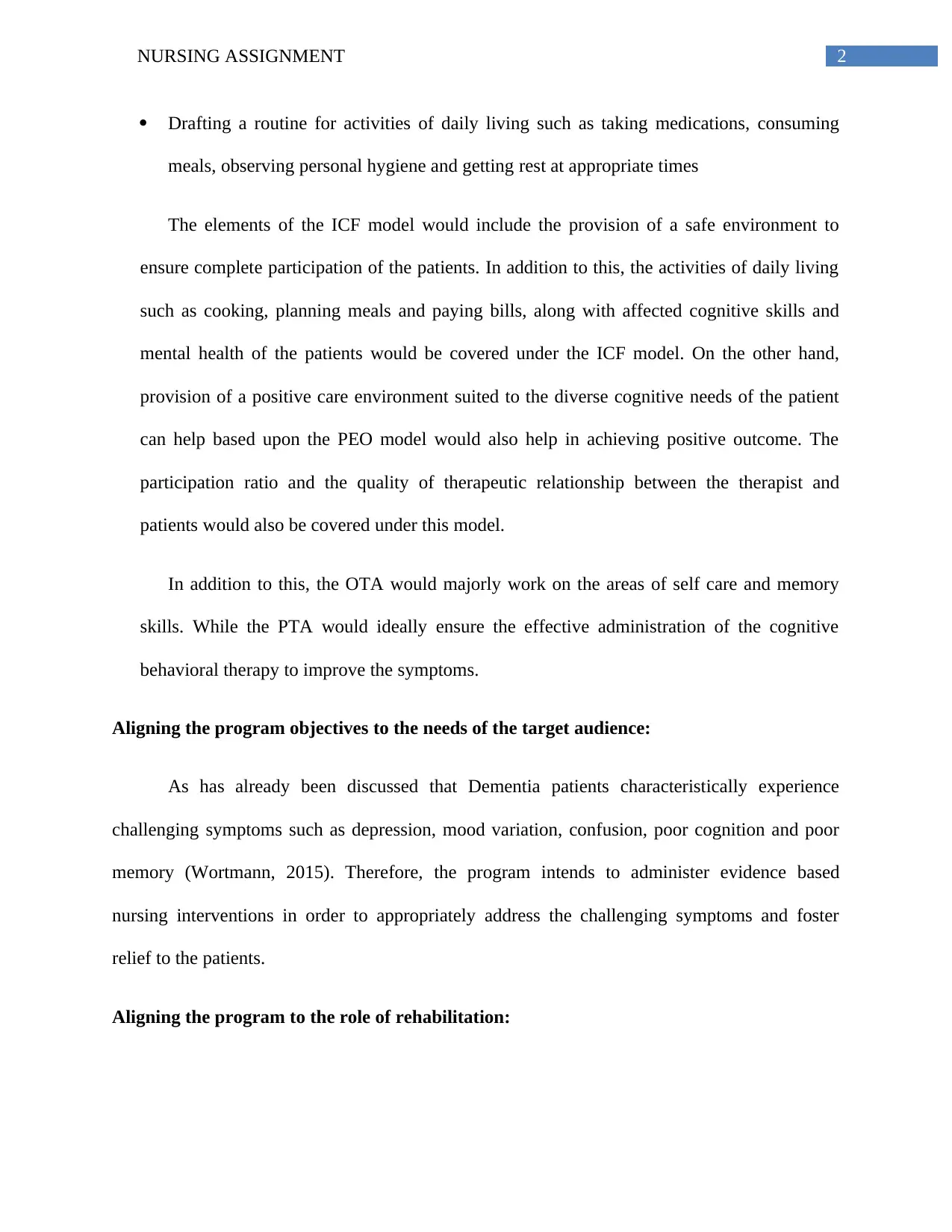
2NURSING ASSIGNMENT
Drafting a routine for activities of daily living such as taking medications, consuming
meals, observing personal hygiene and getting rest at appropriate times
The elements of the ICF model would include the provision of a safe environment to
ensure complete participation of the patients. In addition to this, the activities of daily living
such as cooking, planning meals and paying bills, along with affected cognitive skills and
mental health of the patients would be covered under the ICF model. On the other hand,
provision of a positive care environment suited to the diverse cognitive needs of the patient
can help based upon the PEO model would also help in achieving positive outcome. The
participation ratio and the quality of therapeutic relationship between the therapist and
patients would also be covered under this model.
In addition to this, the OTA would majorly work on the areas of self care and memory
skills. While the PTA would ideally ensure the effective administration of the cognitive
behavioral therapy to improve the symptoms.
Aligning the program objectives to the needs of the target audience:
As has already been discussed that Dementia patients characteristically experience
challenging symptoms such as depression, mood variation, confusion, poor cognition and poor
memory (Wortmann, 2015). Therefore, the program intends to administer evidence based
nursing interventions in order to appropriately address the challenging symptoms and foster
relief to the patients.
Aligning the program to the role of rehabilitation:
Drafting a routine for activities of daily living such as taking medications, consuming
meals, observing personal hygiene and getting rest at appropriate times
The elements of the ICF model would include the provision of a safe environment to
ensure complete participation of the patients. In addition to this, the activities of daily living
such as cooking, planning meals and paying bills, along with affected cognitive skills and
mental health of the patients would be covered under the ICF model. On the other hand,
provision of a positive care environment suited to the diverse cognitive needs of the patient
can help based upon the PEO model would also help in achieving positive outcome. The
participation ratio and the quality of therapeutic relationship between the therapist and
patients would also be covered under this model.
In addition to this, the OTA would majorly work on the areas of self care and memory
skills. While the PTA would ideally ensure the effective administration of the cognitive
behavioral therapy to improve the symptoms.
Aligning the program objectives to the needs of the target audience:
As has already been discussed that Dementia patients characteristically experience
challenging symptoms such as depression, mood variation, confusion, poor cognition and poor
memory (Wortmann, 2015). Therefore, the program intends to administer evidence based
nursing interventions in order to appropriately address the challenging symptoms and foster
relief to the patients.
Aligning the program to the role of rehabilitation:
⊘ This is a preview!⊘
Do you want full access?
Subscribe today to unlock all pages.

Trusted by 1+ million students worldwide
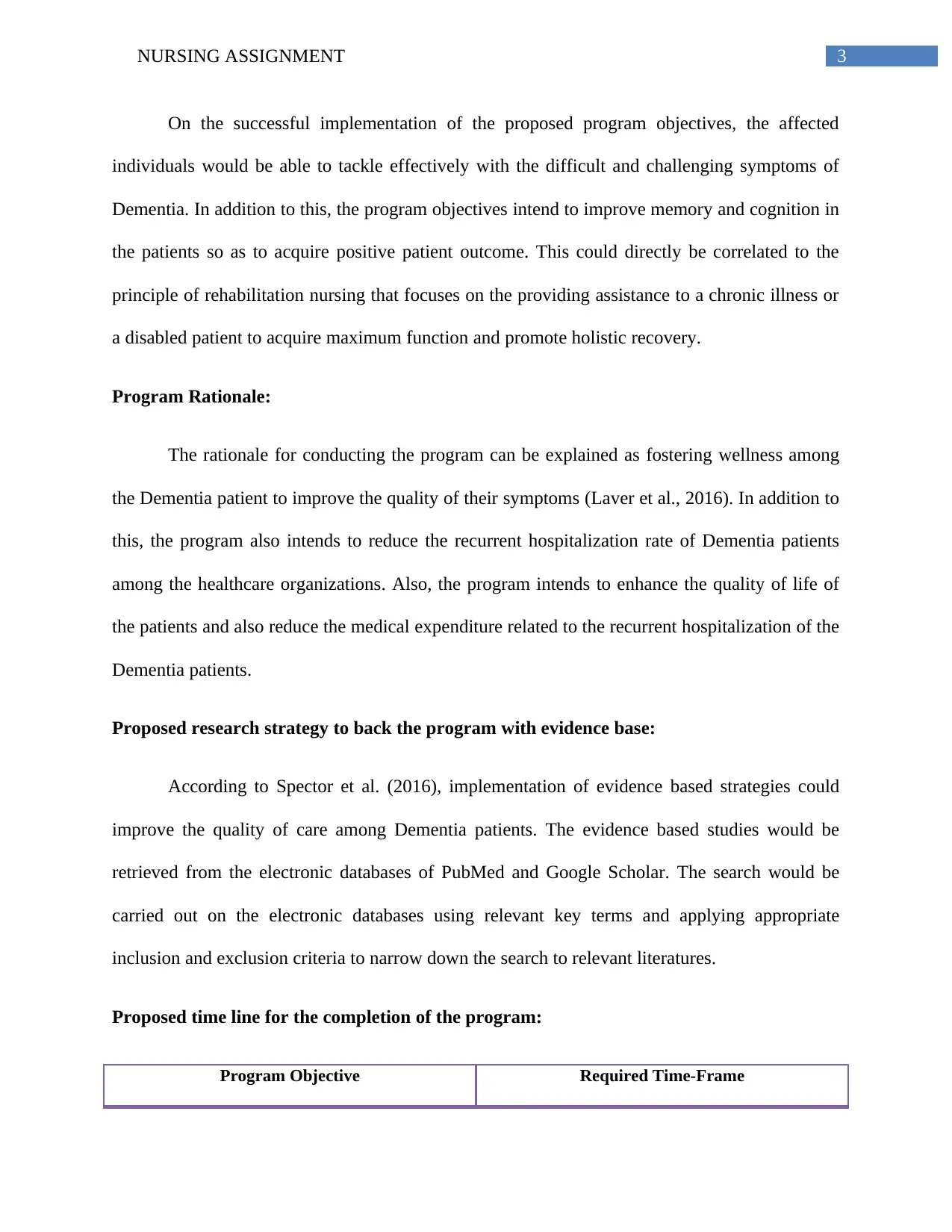
3NURSING ASSIGNMENT
On the successful implementation of the proposed program objectives, the affected
individuals would be able to tackle effectively with the difficult and challenging symptoms of
Dementia. In addition to this, the program objectives intend to improve memory and cognition in
the patients so as to acquire positive patient outcome. This could directly be correlated to the
principle of rehabilitation nursing that focuses on the providing assistance to a chronic illness or
a disabled patient to acquire maximum function and promote holistic recovery.
Program Rationale:
The rationale for conducting the program can be explained as fostering wellness among
the Dementia patient to improve the quality of their symptoms (Laver et al., 2016). In addition to
this, the program also intends to reduce the recurrent hospitalization rate of Dementia patients
among the healthcare organizations. Also, the program intends to enhance the quality of life of
the patients and also reduce the medical expenditure related to the recurrent hospitalization of the
Dementia patients.
Proposed research strategy to back the program with evidence base:
According to Spector et al. (2016), implementation of evidence based strategies could
improve the quality of care among Dementia patients. The evidence based studies would be
retrieved from the electronic databases of PubMed and Google Scholar. The search would be
carried out on the electronic databases using relevant key terms and applying appropriate
inclusion and exclusion criteria to narrow down the search to relevant literatures.
Proposed time line for the completion of the program:
Program Objective Required Time-Frame
On the successful implementation of the proposed program objectives, the affected
individuals would be able to tackle effectively with the difficult and challenging symptoms of
Dementia. In addition to this, the program objectives intend to improve memory and cognition in
the patients so as to acquire positive patient outcome. This could directly be correlated to the
principle of rehabilitation nursing that focuses on the providing assistance to a chronic illness or
a disabled patient to acquire maximum function and promote holistic recovery.
Program Rationale:
The rationale for conducting the program can be explained as fostering wellness among
the Dementia patient to improve the quality of their symptoms (Laver et al., 2016). In addition to
this, the program also intends to reduce the recurrent hospitalization rate of Dementia patients
among the healthcare organizations. Also, the program intends to enhance the quality of life of
the patients and also reduce the medical expenditure related to the recurrent hospitalization of the
Dementia patients.
Proposed research strategy to back the program with evidence base:
According to Spector et al. (2016), implementation of evidence based strategies could
improve the quality of care among Dementia patients. The evidence based studies would be
retrieved from the electronic databases of PubMed and Google Scholar. The search would be
carried out on the electronic databases using relevant key terms and applying appropriate
inclusion and exclusion criteria to narrow down the search to relevant literatures.
Proposed time line for the completion of the program:
Program Objective Required Time-Frame
Paraphrase This Document
Need a fresh take? Get an instant paraphrase of this document with our AI Paraphraser
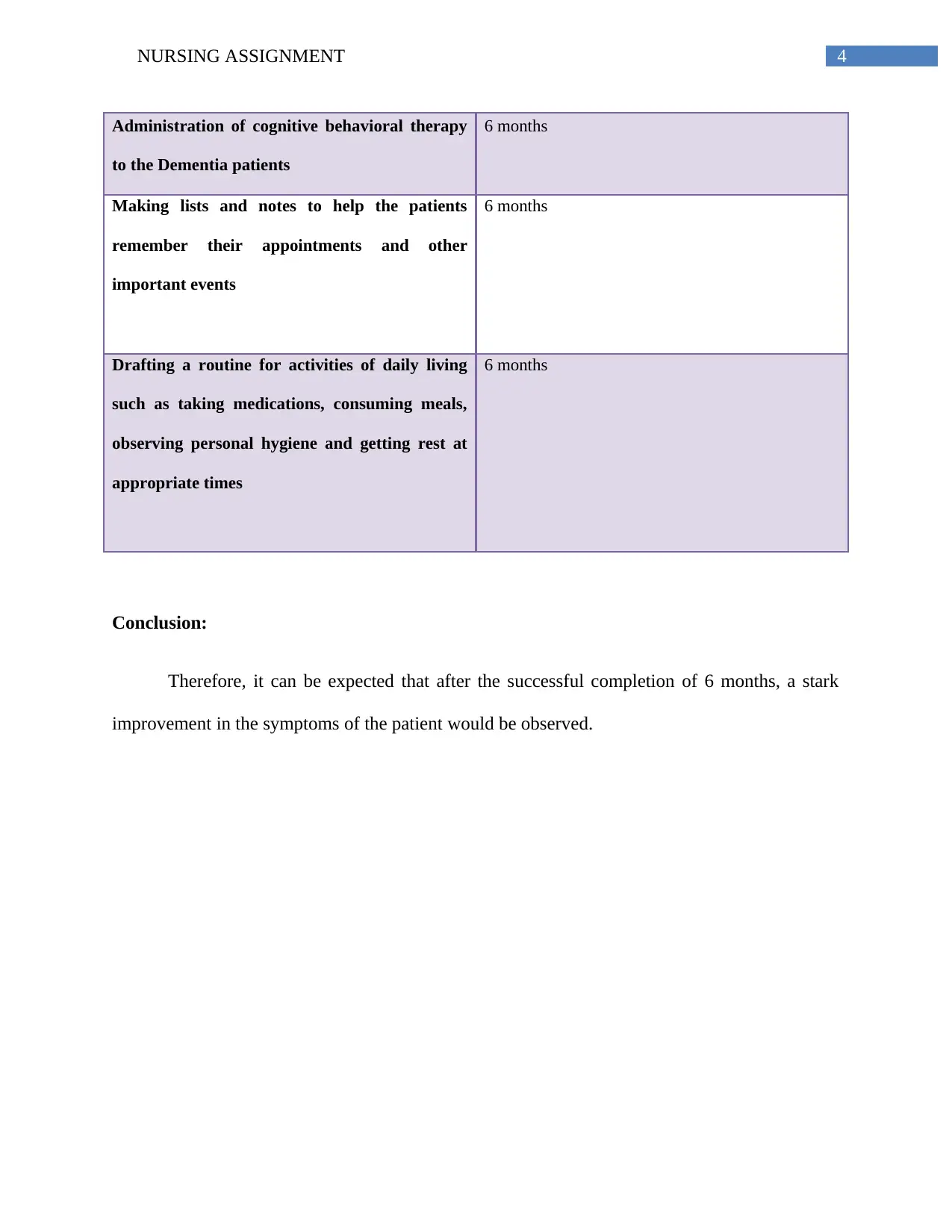
4NURSING ASSIGNMENT
Administration of cognitive behavioral therapy
to the Dementia patients
6 months
Making lists and notes to help the patients
remember their appointments and other
important events
6 months
Drafting a routine for activities of daily living
such as taking medications, consuming meals,
observing personal hygiene and getting rest at
appropriate times
6 months
Conclusion:
Therefore, it can be expected that after the successful completion of 6 months, a stark
improvement in the symptoms of the patient would be observed.
Administration of cognitive behavioral therapy
to the Dementia patients
6 months
Making lists and notes to help the patients
remember their appointments and other
important events
6 months
Drafting a routine for activities of daily living
such as taking medications, consuming meals,
observing personal hygiene and getting rest at
appropriate times
6 months
Conclusion:
Therefore, it can be expected that after the successful completion of 6 months, a stark
improvement in the symptoms of the patient would be observed.
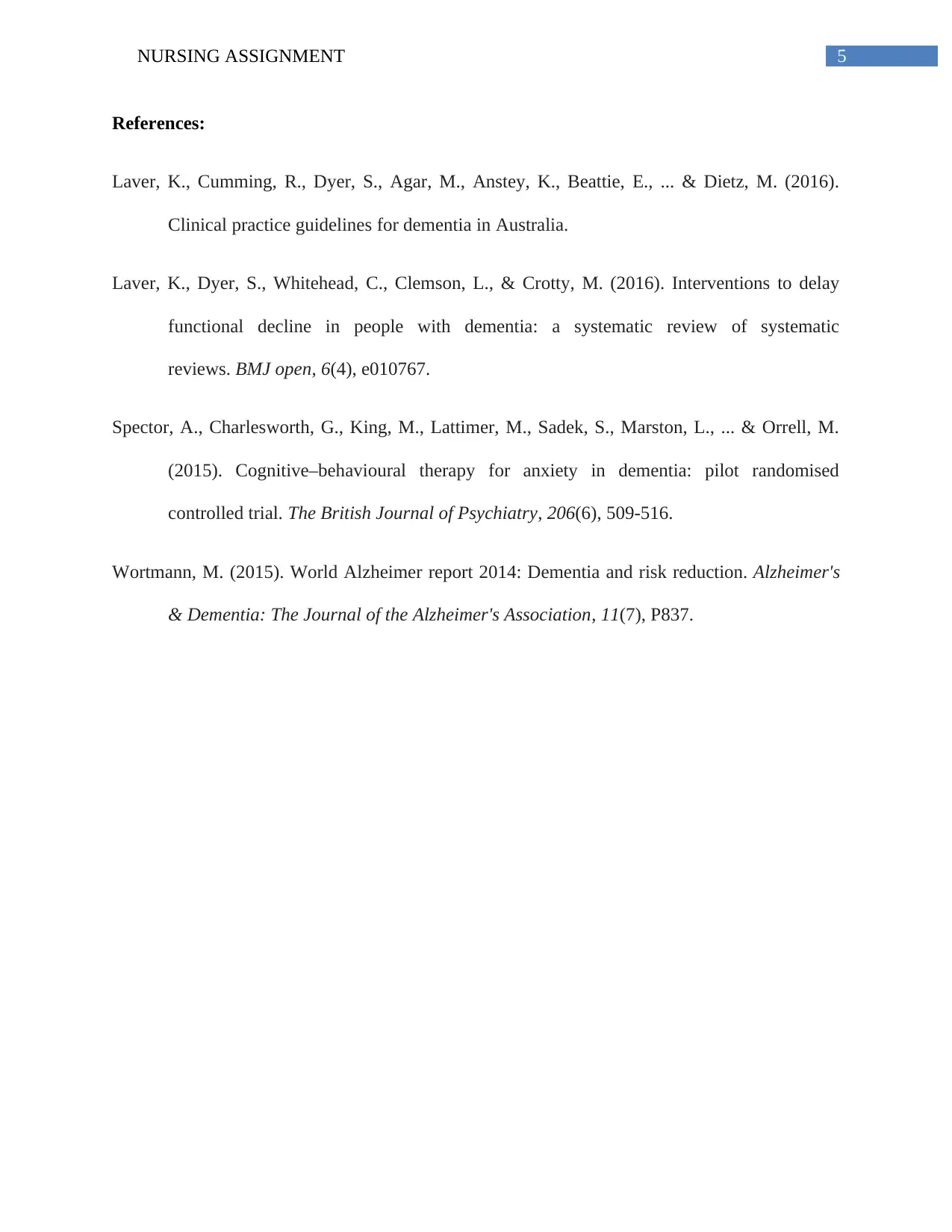
5NURSING ASSIGNMENT
References:
Laver, K., Cumming, R., Dyer, S., Agar, M., Anstey, K., Beattie, E., ... & Dietz, M. (2016).
Clinical practice guidelines for dementia in Australia.
Laver, K., Dyer, S., Whitehead, C., Clemson, L., & Crotty, M. (2016). Interventions to delay
functional decline in people with dementia: a systematic review of systematic
reviews. BMJ open, 6(4), e010767.
Spector, A., Charlesworth, G., King, M., Lattimer, M., Sadek, S., Marston, L., ... & Orrell, M.
(2015). Cognitive–behavioural therapy for anxiety in dementia: pilot randomised
controlled trial. The British Journal of Psychiatry, 206(6), 509-516.
Wortmann, M. (2015). World Alzheimer report 2014: Dementia and risk reduction. Alzheimer's
& Dementia: The Journal of the Alzheimer's Association, 11(7), P837.
References:
Laver, K., Cumming, R., Dyer, S., Agar, M., Anstey, K., Beattie, E., ... & Dietz, M. (2016).
Clinical practice guidelines for dementia in Australia.
Laver, K., Dyer, S., Whitehead, C., Clemson, L., & Crotty, M. (2016). Interventions to delay
functional decline in people with dementia: a systematic review of systematic
reviews. BMJ open, 6(4), e010767.
Spector, A., Charlesworth, G., King, M., Lattimer, M., Sadek, S., Marston, L., ... & Orrell, M.
(2015). Cognitive–behavioural therapy for anxiety in dementia: pilot randomised
controlled trial. The British Journal of Psychiatry, 206(6), 509-516.
Wortmann, M. (2015). World Alzheimer report 2014: Dementia and risk reduction. Alzheimer's
& Dementia: The Journal of the Alzheimer's Association, 11(7), P837.
⊘ This is a preview!⊘
Do you want full access?
Subscribe today to unlock all pages.

Trusted by 1+ million students worldwide
1 out of 6
Related Documents
Your All-in-One AI-Powered Toolkit for Academic Success.
+13062052269
info@desklib.com
Available 24*7 on WhatsApp / Email
![[object Object]](/_next/static/media/star-bottom.7253800d.svg)
Unlock your academic potential
Copyright © 2020–2025 A2Z Services. All Rights Reserved. Developed and managed by ZUCOL.





